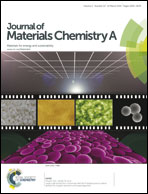Hierarchical core–shell α-Fe2O3@C nanotubes as a high-rate and long-life anode for advanced lithium ion batteries†
Abstract
High-performance anode materials in lithium ion batteries greatly rely on the elaborate control of their size, shape, structure and surface. However, it is difficult to assemble all of the controls within one particle, due to difficulties in their synthesis. Here, hierarchical carbon-coated α-Fe2O3 nanotubes are prepared by a facile hydrothermal reaction between branched MnO2/Fe2O3 nanorods and glucose. The resulting nanotubes realize all these controls in one particle in terms of their nanoscale size, one-dimensional shape, hollow structure, hierarchical surface and carbon coating. Meanwhile, the thickness of the carbon layer could be easily controlled by the ratio between the different reactants. Electrochemical measurements show that the core–shell nanotubes with the thinnest carbon layer give the best cycling and rate performances. They deliver a specific capacity of 1173 mA h g−1 after 100 cycles at a current density of 0.2 A g−1, or 1012 mA h g−1 after 300 cycles at 1 A g−1. Even after 1000 cycles at a current density of 4 A g−1, the specific capacity could be still kept at 482 mA h g−1. The excellent lithium-storage performance could be attributed to the well-designed controls in this nanocomposite and a thin carbon layer, which increases the electron conductivity of the electrode and simultaneously keeps the carbon content lower.


 Please wait while we load your content...
Please wait while we load your content...